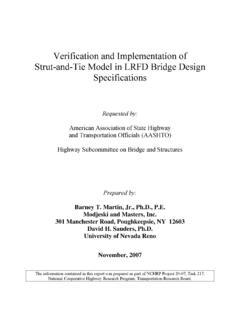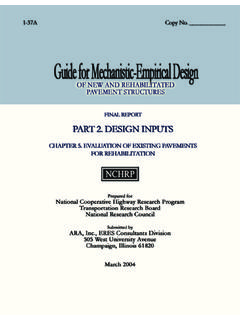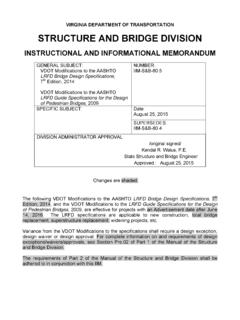Transcription of BRIDGE CONSTRUCTION PRACTICES USING …
1 BRIDGE CONSTRUCTION PRACTICES USING incremental launching Requested by: American Association of State Highway and Transportation Officials (AASHTO) Highway Subcommittee on BRIDGE and Structures Prepared by: Mike LaViolette HNTB Corporation Kansas City, Missouri 64106 Terry Wipf Yoon-Si Lee Jake Bigelow Brent Phares BRIDGE Engineering Center Center for Transportation Research and Education Iowa State University Ames, Iowa 50011 December, 2007 The information contained in this report was prepared as part of NCHRP Project 20-07, Task 229, National Cooperative Highway Research Program, Transportation Research Board. ii Acknowledgements This study was requested by the American Association of State Highway and Transportation Officials (AASHTO), and conducted as part of National Cooperative Highway Research Program (NCHRP) Project 20-07. The NCHRP is supported by annual voluntary contributions from the state Departments of Transportation. Project 20-07 is intended to fund quick response studies on behalf of the AASHTO Standing Committee on Highways.
2 The report was prepared by Mike LaViolette of HNTB Corp., Terry Wipf, Yoon-Si Lee, Jake Bigelow and Brent Phares of The BRIDGE Engineering Center at Iowa State Univeristy. The work was guided by a task group which included Ahmad Abu-Hawash, Robert J. Healy, Finn Hubbard, Vasant Mistry, Danna Powell, David Rogowski, Mohammed Sheikhizadeh, and Dan Timmons. The project was managed by David B. Beal, , NCHRP Senior Program Officer. Disclaimer The opinions and conclusions expressed or implied are those of the research agency that performed the research and are not necessarily those of the Transportation Research Board or its sponsors. This report has not been reviewed or accepted by the Transportation Research Board's Executive Committee or the Governing Board of the National Research Council. - iii - iiiTABLE OF CONTENTS SUMMARY ..V INTRODUCTION ..1 REVIEW OF CURRENT PRACTICE ..2 Literature Review ..2 Survey of State DOT BRIDGE MANUAL OF BEST PRACTICE ..22 Preliminary Design and Planning Considerations.
3 22 Final Design Phase Recommended CONSTRUCTION Phase Considerations ..27 Applicability and Limitations of incremental Case Studies ..31 STRATEGIC PLAN FOR INCREASING USE OF incremental launching METHOD ..55 APPENDIX A .. A-1 Database of Incrementally Launched Bridges .. A-1 APPENDIX B ..B-1 Survey of State DOT BRIDGE APPENDIX C ..C-1 Details of incremental launching Systems ..C-1 APPENDIX D .. D-1 Example Details for Launched BRIDGE D-1 APPENDIX E ..E-1 Example Specifications for Steel Erection by launching ..E-1 iv LIST OF FIGURES Figure 1. launching nose resting on a temporary pier ..12 Figure 2. Port Wakefield Road BRIDGE launching - Figure 3. Blanchetown BRIDGE launching - Australia..14 Figure 4. Tubun flyover BRIDGE launching LIST OF TABLES Table 1. Perceived advantages of ILM compared to conventional Table 2. Perceived disadvantages of ILM compared to conventional CONSTRUCTION ..18 Table 3. Types of useful tools for design of ILM projects ..19 Table 4 Types of useful tools to promote consideration of ILM projects.
4 21 vSUMMARY BRIDGE CONSTRUCTION over deep valleys, water crossings with steep slopes, or environmentally protected regions can offer many challenges. The incremental launching method (ILM) for BRIDGE CONSTRUCTION may offer advantages over conventional CONSTRUCTION , including creating minimal disturbance to surroundings, providing a more concentrated work area for superstructure assembly, and possibly increased worker safety given the improved erection environment. The ILM involves assembly of the BRIDGE superstructure on one side of an obstacle to be crossed, and then movement (or launching ) of the superstructure longitudinally into its final position. Despite potential advantages for certain situations, the use of the ILM for BRIDGE CONSTRUCTION has been very limited in the United States. The objective of the work summarized in this report was to provide BRIDGE owners, designers, and contractors with information about the ILM, including applications, limitations and benefits.
5 To clarify the ILM procedure and the current state of practice, a comprehensive literature search and survey were conducted. Recommendations pertaining to best PRACTICES for planning, design, and CONSTRUCTION activities, as well as applications and limitations for the ILM are also provided. Case studies are presented, which provide specific ILM BRIDGE project information. The use of the ILM for BRIDGE CONSTRUCTION will never be the most efficient way to construct every single BRIDGE . However, it is thought that a wider understanding of the applicability and potential benefits would allow potential owners, designers, and contractors to make well-informed decisions as to its use for their upcoming projects. 1 INTRODUCTION Bridges have been constructed USING the incremental launching method (ILM) for many years. In this method of CONSTRUCTION , the BRIDGE superstructure is assembled on one side of the obstacle to be crossed and then pushed longitudinally (or launched ) into its final position.
6 The launching is typically performed in a series of increments so that additional sections can be added to the rear of the superstructure unit prior to subsequent launches. The launching method has also been applied to tied-arch or truss spans, although these are fully assembled prior to launching . The incremental launching method will never become the most economical procedure for constructing all bridges. The ILM requires a considerable amount of analysis and design expertise and specialized CONSTRUCTION equipment. However, the ILM may often be the most reasonable way to construct a BRIDGE over an inaccessible or environmentally protected obstacle. When used for the appropriate project, the ILM offers a number of significant advantages to both the owner and the contractor, including the following: Minimal disturbance to surroundings including environmentally sensitive areas Smaller, but more concentrated area required for superstructure assembly Increased worker safety since all erection work is performed at a lower elevation The ILM can be used to construct a BRIDGE over a wide range of challenging sites which feature limited or restricted access, including those with the following characteristics: Deep valleys Deep water crossings Steep slopes or poor soil conditions making equipment access difficult Environmentally protected species or cultural resources beneath the BRIDGE It is estimated that over 1,000 bridges worldwide have been constructed USING the incremental launching method.
7 Swanson (1979) states that the first incrementally launched highway BRIDGE in the United States was constructed near Covington, Indiana in 1977. One of the earliest published reports in North America, however, describes the CONSTRUCTION of a railroad truss span for the Canadian Pacific Railway in 1907. Despite the advantages listed, the incremental launching method of CONSTRUCTION has seen very limited application in the United States. The reason for this disparity is unclear and it is one of the goals of the proposed work to ascertain the reasons for and attempt to eliminate this potential knowledge gap for BRIDGE owners, designers and contractors. Specifically, the project objective is to provide BRIDGE owners, designers, and contractors with information and understanding about the ILM, including applications and benefits. 2 REVIEW OF CURRENT PRACTICE In order to better understand the current state of practice within the United States and the world, the research team conducted a comprehensive literature search In addition, a survey was conducted of all members of the AASHTO Subcommittee on Bridges and Structures (which included all state BRIDGE engineers) to attempt to understand how much they understand about the incremental launching method and where the current study may be most useful to them in considering future projects.
8 Literature Review The following information is provided as an overview of the technical literature available on the topic of incremental launching ; the coverage is broad and includes historical background, studies (primarily analytical) that focus on detailed technical issues related to the launch process, structural monitoring of the launch process, and brief incremental launch project descriptions that provide overview information. Background It is estimated that over 1,000 bridges worldwide have been constructed by the incremental launching method (Gohler 2000), the vast majority of which have been post-tensioned concrete box girder bridges. Their main application has been in Europe, but the method has now spread around the world and the technology has been applied to steel I-girder and box girder bridges as well. In the early 1960s, the modern approach to launching concrete bridges was developed. The first concrete BRIDGE constructed by launching was built over the River Caroni in Venezuela and was completed in 1963 (Podolny 1982; Baur 1977).
9 The BRIDGE was a post-tensioned concrete box girder BRIDGE with a main span of 315 ft. The CONSTRUCTION of this BRIDGE was considered so successful that the launching method was utilized to construct a nearly identical BRIDGE a few years later. The first steel BRIDGE to be launched in the United States is believed to be a Kansas City Southern Railroad box girder BRIDGE near Redland, OK in 1970 (Durkee 1972). The nine-span continuous BRIDGE is 2,110 ft. long with a main span of 330 ft. This BRIDGE was launched in two trains, one from each side of the river. Closure of the BRIDGE was accomplished at mid-span of the main span. This method of CONSTRUCTION can be applied to bridges made of either steel or concrete materials. The vast majority of concrete bridges built by the ILM were cast in stationary forms behind an abutment. Each new segment is cast directly against the preceding one; then, once proper curing has taken place, the entire structure is launched to create sufficient room for casting the 3subsequent segment.
10 A steel BRIDGE constructed by ILM is completely assembled (typically one span or more at a time), including steel cross frames and bracing, prior to launching operations. During the launching operation, the BRIDGE superstructure is supported by a series of rollers or sliding bearings. These rollers are removed following the launching and the BRIDGE is lowered to rest on permanent bearings identical to those used for a conventionally constructed BRIDGE . The thrust required to launch the BRIDGE forward can be provided by a variety of jacking systems, including hydraulic pistons or hollow-core strand jacks more commonly used for post-tensioning. In order to reduce the cantilever moments and the amount of deflection that occurs during launching operations, one of two systems (and sometimes both) may typically be employed. The contractor can construct a tapered launching nose on the leading end of the girders. The launching nose reduces the dead load of the cantilever span and utilizes its tapered profile to assist in lifting the mass of the girders as they are launched forward onto the landing pier.
















